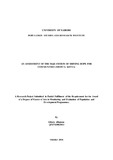An Assessment of the M&e System of Shining Hope for Communities (Shofco, Kenya)
| dc.contributor.author | Gituru, Albanous | |
| dc.date.accessioned | 2016-12-22T09:15:11Z | |
| dc.date.available | 2016-12-22T09:15:11Z | |
| dc.date.issued | 2016 | |
| dc.identifier.uri | http://hdl.handle.net/11295/98267 | |
| dc.description.abstract | The purpose of the study was to assess the M&E system of Shining Hope for Communities (SHOFCO) and generally determine the extent to which SHOFCO’s M&E system met the standards of a functional M&E system. The researcher specifically sought to determine how the M&E system of SHOFCO meets the core components of resources and capacity building; determine extent to which data collection and management of SHOFCO system is within the set M&E standards; and ascertain how M&E data is disseminated and utilized by SHOFCO. The study was guided by the systems approach to M&E systems; identifying the interrelated system components and assessing functionality of each component which in turn reflects the functionality of the whole system. The assessment operationalized FHI 360's Participatory M&E System Assessment Tool. The study used a survey design to collect data on various components in the SHOFCO M&E system. Key informant discussion guide was used to collect data by interviewing 9 respondents purposively sampled from SHOFCO M&E department, project staff and management. The researcher also used observation and documents review to collect and validate data. Data was analysed using both qualitative and quantitative methods. The findings indicated that SHOFCO’s M&E system has adequately met the standards with an overall score of 172 out of a possible 202 representing 85%. Plans, Guidelines & Operational Documents component scored below average getting 47% whereas Data Verification component scored maximum points of 50 against 50. The study recommends that SHOFCO management should develop guidelines for orienting new staff in M&E system and develop a long term M&E capacity building program to enhance capacity of M&E staff on critical issues such as data analysis and evaluation. SHOFCO management should also develop comprehensive Program Management Plans (PMPs) with operational definitions of project indicators. A separate organogram for M&E department should be developed and guidelines to protect client’s confidential information. Document data back-up procedures should be documented as well as program databases so as to codify organizational knowledge in case of staff turnover. The study also identified potential for further research and usage of the FHI 360 assessment tool and recommends that researchers using this tool in assessing M&E system should do independent data analysis outside the confines of the tool in order to give a more objective judgement of the system allowing for further correlation analysis between components. | en_US |
| dc.language.iso | en_US | en_US |
| dc.publisher | University of Nairobi | en_US |
| dc.rights | Attribution-NonCommercial-NoDerivs 3.0 United States | * |
| dc.rights.uri | http://creativecommons.org/licenses/by-nc-nd/3.0/us/ | * |
| dc.title | An Assessment of the M&e System of Shining Hope for Communities (Shofco, Kenya) | en_US |
| dc.type | Thesis | en_US |



